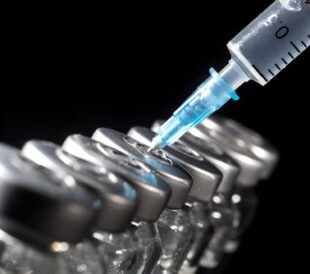 Measurement of insulin-like growth factor 1 (IGF1), a 70-amino acid, single-chain polypeptide that acts as a mediator for the effects of growth hormone, is complicated by its close association with the binding proteins IGFBP-1 through IGFBP-6. Over 98% of circulating IGF is bound, with approximately 80% found as an 150-kDa ternary complex in association with IGFBP-3 and an acid labile subunit (ALS).1 This close association makes immunoassay difficult; IGF must first be physically dissociated during laborious sample preparation. IGF1 is of interest for measuring growth hormone status, in cancer research, and in sports anti-doping surveillance as a growth hormone biomarker. Because assays are routinely run with many samples and because standardization for international research collaboration is needed, mass spectrometric techniques are strong candidates for development in this field.
Measurement of insulin-like growth factor 1 (IGF1), a 70-amino acid, single-chain polypeptide that acts as a mediator for the effects of growth hormone, is complicated by its close association with the binding proteins IGFBP-1 through IGFBP-6. Over 98% of circulating IGF is bound, with approximately 80% found as an 150-kDa ternary complex in association with IGFBP-3 and an acid labile subunit (ALS).1 This close association makes immunoassay difficult; IGF must first be physically dissociated during laborious sample preparation. IGF1 is of interest for measuring growth hormone status, in cancer research, and in sports anti-doping surveillance as a growth hormone biomarker. Because assays are routinely run with many samples and because standardization for international research collaboration is needed, mass spectrometric techniques are strong candidates for development in this field.
Scientists at Thermo Scientific have developed a selected reaction monitoring mass spectrometric immunoassay (SRM-MSIA) for IGF1 that simplifies the extraction procedure, increases sensitivity and speeds the workflow by enhancing the potential for automation.2 The assay uses an automated microtiter plate strategy that shows great promise for development as a high-throughput laboratory assay.
The scientists developed the SRM-MSIA using individual human plasma and serum samples from a commercial source. All samples contained long arginine 3–IGF1 (LR3-IGF1) added as an internal reference standard prior to preparation. LR3-IGF1 is a synthetic analogue with reduced affinity for the IGFBPs that differs from native IGF1 by containing arginine in place of glutamic acid at position 3 in the amino acid chain and a 13-amino acid extension at the N-terminus. Once validated, the scientists compared the new assay to a routine enzyme-linked immunosorbent assay (ELISA) using a further 289 human serum samples.
Niederkofler et al. prepared samples for SRM-MSIA by first disrupting the IGFBP-IGF1 binding. This was done by agitating serum or standards in microtiter plates with sodium dodecyl sulfate (SDS) buffer to dissociate IGF1 from the IGFBPs. Following this, IGF1 was captured using customized MSIA pipette tips (Thermo Scientific) containing anti-human IGF1 antibody immobilized within a porous matrix. After this immuno-enrichment step, the retained analytes were eluted into microtiter wells, where they underwent trypsin digestion for one hour at 50°C before SRM using a TSQ Vantage triple quadrupole mass spectrometer (Thermo Scientific). The scientists then analyzed the spectral data using Pinpoint software.
Standard curves generated showed an assay range of 1 to 1,500 ng/ml, with a lower limit of quantifications at 5 ng/ml. The scientists obtained good linearity with serial dilutions (R2= 0.999, SEE = 0.135) and found 94% to 110% recovery when compared with expected results. In addition, samples spiked with recombinant human IGF1 gave 88–121% recoveries. Intra- and inter-assay coefficients of variation were each less than 10%.
Compared to the standard ELISA, SRM-MSIA IGF1 concentrations correlated well but with a slight negative bias. The authors do not comment directly on this, but do state that before their method is adopted widely, it needs further calibration with international IGF1 standards.
In summary, the SRM-MSIA microtiter plate method developed by Niederkofler et al. shows potential for accurately measuring circulating IGF1 concentrations in plasma and serum. Furthermore, with automated sample handling using the Versette Automated Liquid Handler (Thermo Scientific), the assay runs extremely quickly, with preparation and elution steps taking less than 45 minutes for 96 samples. As discussed in a previous Accelerating Proteomics article, high-throughput MSIA could eventually replace traditional ELISA for measuring low-abundance circulating proteins.
More information may be found via the corresponding webinar, “MSIA-SRM: Next Generation Method for Insulin-Like Growth Factor-1 Measurement.”
References
1. Baxter, R.C. (1988) “Characterization of the acid-labile subunit of the growth hormone-dependent insulin-like growth factor binding protein complex,” Journal of Clinical Endocrinology and Metabolism, 67(2) (pp. 265–72).
2. Niederkofler, E.E., et al. (2013) “Targeted Selected Reaction Monitoring Mass Spectrometric Immunoassay for Insulin-like Growth Factor 1,” PLOS ONE, 8(11), doi: 10.1371/journal.pone.0081125.
Post Author: Amanda Maxwell. Mixed media artist; blogger and social media communicator; clinical scientist and writer; SAHM and expat trailing spouse.
A digital space explorer, engaging readers by translating complex theories and subjects creatively into everyday language.




Leave a Reply